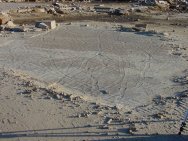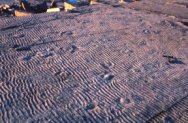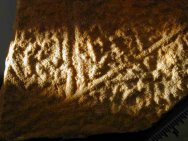Blackberry Hill, Elk Mound Group of central Wisconsin"First Footprints on Land"Some 510 million years ago during a shadowy, Cambrian time, what we now call Wisconsin was way south, some 10 degrees below the equator. The diversity of life then was still expanding, with new forms radiating, with the new forms themselves exerting new types of selective pressures to further drive evolutionary processes. The Black Berry Hill site (Krukowski flagstone quarry) of Central Wisconsin near Mosinee (outcrops of the Mount Simon and Wonewoc Sandstone, Elk Mound Group), was then beachfront property of Laurentia (late Cambrian - Furongian time), with the burgeoning life forms of the pelagic environment lying just offshore. Hagadorn posits an ancient environment comprising inter-fingering shallow marine, fluvial and eolian facies. Paleobiology has many mysteries, and of these, the early venturing of life onto land is one of the most mysterious. Many clues to these mysteries are buried in the Blackberry Hill site. Recently, many Ichnofossils, as well as body fossil impressions, were exposed in its various horizons and studied by a number of paleontologists. No shelly animals are found at the Blackberry Hill site, only trackways (Ichnofossils) and body impressions of Jellyfish and arthropods. Apparently, hard body parts such as trilobite exoskeletons never underwent mineralization, but were instead dissolved back into the sea. Besides a few mysterious trackways that can not be named, one finds Diplichnites, Protichnites and Climactichnites, and most recently a putative trackmaker arthropod from the enigmatic Euthycarcinoid or Aglaspid groups. These fossils were only recently interpreted paleontologists. But ichnofossils in many ways are more revealing than body preservation, because they can give hints about animal behavior and interaction in the ecosystem, and in the case of the Blackberry Hill fossils, possibly the first footprints on land in the fossil record. Thus, hopefully, the result will be some shedding of more light on this shadowy period of geological history. The ichnofossils of the Elk Mound Group possibly encode an early step toward colonization of the land, an evolutionary trend that would gain tremendous momentum during the Paleozoic. It is likely that these earliest of terrestrial footprints were made by animals that could leave the water to the intertidal areas for brief periods. In so doing, they had a brief reprieve from marine predators while grazing on abundant microbial biofilms.
|
|
Fossil Mall Navigation: Navigate
by Fossil Category: l Fossils and Paleotological Science Information l |
||||||


